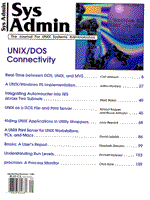
Sidebar: About SAMBA
The SAMBA package is a collection of programs written by Andrew Tridgell, with the help of a number of other people on the Internet. It was written specifically to allow Windows PCs, preferably Windows for Workgroups PCs, to share directories and printers on UNIX hosts. It would enable you to build up a small network using a simple UNIX host and a number of WfW PCs. The package is available on the Internet. We downloaded it from a well-known Linux archive on the Internet, sunsite.unc.edu. You can find it in the following directory:
ftp://sunsite.unc.edu/pub/Linux/system/Network/samba
You can compile SAMBA on a great number of platforms, not only the public domain ones like Linux and FreeBSD, but also Solaris, AIX, and OSF/1. The documentation on this is quite straightforward and provides enough information to allow you to build it on your platform. Your best bet is to use either the native compiler on the platform or the GNU C compiler, which is also supported in the Makefile. In effect, SAMBA emulates a LAN Manager server on the net. It captures the LAN Manager network messages and processes them. Thus clients based on the LAN Manager protocol can connect to the UNIX machine. Such clients include Windows for Workgroups, OS/2, and Windows NT. The LAN Manager concept is based upon services -- named network resources offered by the server. A resource can be a disk service, for storing and retrieving data, or a print service, enabling printer sharing on the network. Clients can access these services by the name given on the server. They will then be mapped to a local pseudo device, either a disk or a printer. The client can access services by accessing the local pseudo device. The basic transport mechanism of SAMBA is based on TCP/IP. This poses no real problem for the UNIX side, since UNIX systems are, in general, already equipped with a TCP/IP stack. The TCP/IP protocol is directly configured in the UNIX kernel and you need only configure it properly to get it up and running. The desktop side is a different story. The Microsoft Windows environment is not normally equipped with a TCP/IP protocol stack, nor is the LAN Manager software. So you must find a working combination of both, on the platform you want to connect to the UNIX server. Fortunately, Windows 95 does come equipped with both a TCP/IP stack and a LAN Manager Client. All that is necessary is to configure it on the desktop machine. SAMBA contains its own configuration file, in which you can define services and users who are authorized to use these services. The main article provides a number of examples of how to configure these services.
|